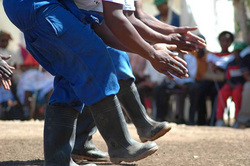Narrative

Gumboot dancing was created in the South African gold mines in the 1880's. The work in the mines was extremely hard, exhausting work, where talking was forbidden. It was a very dangerous line of work, and hundreds of men were killed each year. White owners would kick and beat the slaves and the working conditions were hazardous. Due to poor or non-existent drainage systems, the mines would flood, and the workers began to develop skin problems and ulcers from standing in the unsanitary water for so long. The white bosses issued rubber gumboots to the workers to cut down on these issues because it was cheaper than installing drainage systems. The gumboots were the start of the miner's uniform, which consisted of the boots to protect the feet, jeans or overalls, bare chests, and bandannas to absorb sweat from their foreheads. Since the workers were forbidden to speak, they began slapping their boots and rattling their ankle chains to communicate with one another in the darkness of the mines. These rhythms turned into a creative dance form and a source of entertainment during their free time.
Gumboot dancing is referred to today as stepping. It is most popular among the male African American population. The dancers have expanded on the traditional steps, adding contemporary moves and music. Stepping requires great physical endurance and is a very fast paced dance. People participate in stepping to celebrate the body as a musical instrument and to express themselves to others. Many fraternities and U.S militaries do stepping as a sign of unity and brotherhood.
I chose to research stepping further because I feel it has a very powerful and emotional history. The slaves endured so much torture and mistreatment during the 1800's, and those miners were just one example of the pain endured. When I watched a video of steppers, I got inspired by their movements and the sounds they created. It fills me with a sense of power and strength when I follow the rhythms they create. It took great strength for those men to work in such horrible conditions, but they were able to endure it and create a dance that would help people all over the world communicate with each other in a new form.
We did a simple stepping exercise in class, but I still found it difficult. We spent fifteen minutes on sixteen basic counts and movements. This made me realize that the dance is not only a source of communication, but also takes great strength and skill to do. It would take a lot of practice to get all the steps memorized and keep in time with the entire group. I was glad I had a chance to experience even a small part of what the original gumboot dancers did. Experiencing only some of the moves the dancers do first hand allows me to feel more connected to them and their great history. This is a truly inspirational dance and I hope it continues to inspire and encourage others as it did me.
Gumboot dancing is referred to today as stepping. It is most popular among the male African American population. The dancers have expanded on the traditional steps, adding contemporary moves and music. Stepping requires great physical endurance and is a very fast paced dance. People participate in stepping to celebrate the body as a musical instrument and to express themselves to others. Many fraternities and U.S militaries do stepping as a sign of unity and brotherhood.
I chose to research stepping further because I feel it has a very powerful and emotional history. The slaves endured so much torture and mistreatment during the 1800's, and those miners were just one example of the pain endured. When I watched a video of steppers, I got inspired by their movements and the sounds they created. It fills me with a sense of power and strength when I follow the rhythms they create. It took great strength for those men to work in such horrible conditions, but they were able to endure it and create a dance that would help people all over the world communicate with each other in a new form.
We did a simple stepping exercise in class, but I still found it difficult. We spent fifteen minutes on sixteen basic counts and movements. This made me realize that the dance is not only a source of communication, but also takes great strength and skill to do. It would take a lot of practice to get all the steps memorized and keep in time with the entire group. I was glad I had a chance to experience even a small part of what the original gumboot dancers did. Experiencing only some of the moves the dancers do first hand allows me to feel more connected to them and their great history. This is a truly inspirational dance and I hope it continues to inspire and encourage others as it did me.

